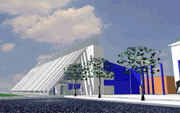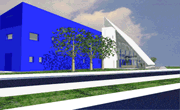Scotland's Science Sensation, Dundee Contemporary
SCOTLAND’S SCIENCE SENSATION As Scotland’s
newest science centre begins to take shape in
Dundee, Hilary McNally takes a look behind the
scenes and finds out why this latest visitor
attraction really will be Sensation-al.
As Scotland’s
newest science centre begins to take shape in
Dundee, Hilary McNally takes a look behind the
scenes and finds out why this latest visitor
attraction really will be Sensation-al.Professor Ian Stevenson, chairman of Scotland’s new £5 million plus science centre Sensation, is convinced the key Millennium project for Tayside, will be a major success, particularly with younger visitors.
Given that science, over the years, hasn’t enjoyed the most positive image in terms of its entertainment value and that, for many, the mere mention of the word can conjure up painful childhood memories of chemical tables and incomprehensible maths formulae, this confidence may appear rather optimistic.
But Professor Stevenson has a not-entirely secret weapon at his disposal in the battle to make science a rip-roaring roller coaster ride of fun and discovery. In fact, he has ten of them, all aged between nine and 13 and tasked with giving grown-ups the low down on what children really find fascinating. The Sensation junior board is an influential component of the whole project - no token gesture to youthful participation this. It has the power to bin an idea it doesn’t like.
"They rejected quite a few of the ideas we came up with for the centre’s name for example,’’ said Professor Stevenson.
"Their opinions are certainly valued. We want to make sure the centre has what children really want rather than what we, as adults, think they want. Our principle purpose is to encourage the next generation of scientists but to do that we have to make it interesting. Science has to be fun. That is what this is about. If it is not fun then it won’t succeed."
If the enthusiasm of the junior board is anything to go by then the centre, which has attracted funding from the Wellcome Trust and the Millennium Commission amongst others, is a guaranteed winner.
"The children are really excited about the whole thing," said educational manager Alice Hague. "They’ve been coming up with their own ideas and they have even carried out market research within their own schools. It has really got them thinking about science and how a project like this develops."
With the outer shell of the building, situated at the back of the Dundee Contemporary Arts Centre, now completed it will not be long before the 1000 square metres of exhibition space begins to fill up. A total of 65 exhibits are planned around sensory themes covering light, heat, taste, touch, smell, position and sound.
 Dundee’s reputation as
a centre of excellence in scientific and medical
research will also be explored with Professor Sir
Alfred Cushieri’s pioneering work on keyhole
surgery and NCR’s automated banking systems
likely to be included.
Dundee’s reputation as
a centre of excellence in scientific and medical
research will also be explored with Professor Sir
Alfred Cushieri’s pioneering work on keyhole
surgery and NCR’s automated banking systems
likely to be included.
"Sensation will be a significant visitor attraction and a huge educational resource for schoolchildren to stimulate their interest in science," said Professor Stevenson. "But it will also be a shop window for the world class science which is going on in Dundee and St Andrews.
"It is unique because it has been scientist lead. Scientists came up with the ideas. People who are busy with their own work and with lecturing all over the place gave up their time to contribute to this and they came up with literally hundreds of ideas. I don’t know of any other science centre that has been developed in this way."
Due to officially open this summer, Sensation will also feature a media room with a wrap around screen and an education room specifically designed for school parties. What it will not include, in keeping with its child friendly philosophy, will be any kind of warnings to keep off the exhibits.
"Everything in the centre will be interactive," said Alice Hague. "The whole idea is that visitors just get stuck in and have a go. So there won’t be a don’t touch sign in the place."
Sounds like fun
already!
.